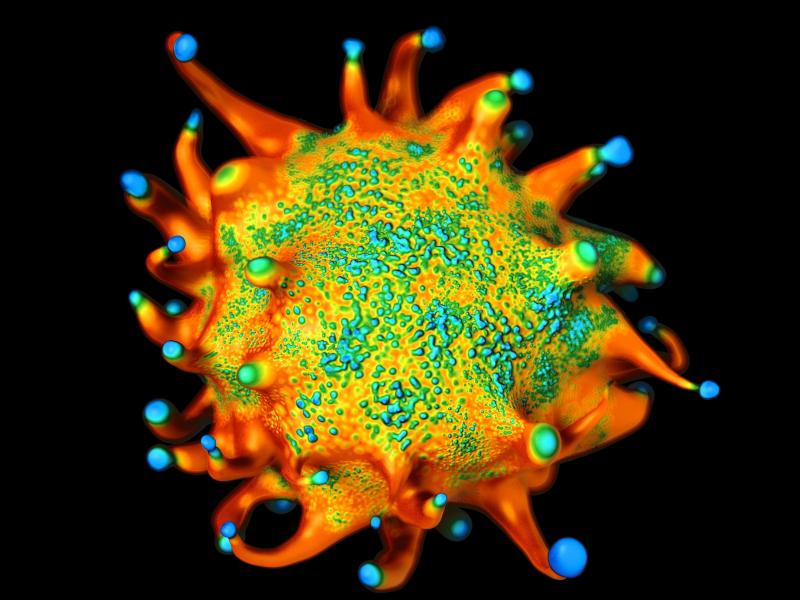Consolidative stem cell transplant may be skipped for MCL patients with undetectable disease





In patients with mantle cell lymphoma (MCL) who have achieved complete remission and undetectable minimal residual disease (MRD) following initial therapy, autologous hematopoietic cell transplantation (auto-HCT) confers no survival advantage when compared with maintenance therapy alone, as shown in the interim results of the phase III ECOG-ACRIN EA4151 trial.
ECOG-ACRIN EA4151 included 650 MCL patients (median age 60 years, 79 percent male, 92 percent White) who were in complete remission after induction therapy. Induction was intensive (contained high-dose cytarabine) in 73 percent of patients and nonintensive in 27 percent. A BTK inhibitor was given during induction in 7.2 percent of patients and during maintenance in 0.3 percent.
After induction therapy, the 516 patients who were MRD-negative (no evidence of cancer) were randomly assigned to receive auto-HCT plus 3 years of maintenance rituximab (n=257) or 3 years of maintenance rituximab alone (n=259). The 49 patients who were MRD-positive (evidence of cancer in one or more cells per million) and 85 who were MRD-indeterminate (testing incomplete or evidence of cancer in greater than zero but less than one cell per million) were assigned to receive auto-HCT plus 3 years of maintenance rituximab.
No OS, PFS benefit
Over a median follow-up of 2.7 years, the overall survival (OS) rate in the MRD-negative group was 82.1 percent for patients who received auto-HCT vs 82.7 percent for those who received maintenance therapy alone (hazard ratio [HR], 1.11, 95 percent confidence interval [CI], 0.71–1.74; p=0.66). The progression-free survival (PFS) rate was 76.6 percent vs 77.4 percent, respectively (HR, 1.05, 95 percent CI, 0.71–1.56; p=0.79). [ASH 2024, abstract LBA-6]
A separate analysis restricted to MRD-negative patients who received their assigned treatment yielded similar results. Those who received auto-HCT plus maintenance therapy and those who received maintenance therapy were not significantly different in terms of the OS (86.2 percent vs 84.8 percent; HR, 1.00, 95 percent CI, 0.58–1.74; p=0.99) and PFS outcomes (81.5 percent vs 80.4 percent; HR, 0.95, 95 percent CI, 0.59–1.54; p=0.84).
Furthermore, the intensity of the induction therapy patients had received to achieve their first remission had no significant impact on the OS outcome.
Based on the interim data, the trial was stopped due to futility.
“I think these results will make physicians comfortable omitting the transplant in patients who are MRD-negative; in the current treatment landscape for MCL, we can achieve good outcomes for these patients without the high-dose chemotherapy and transplant,” said lead study author Dr Timothy Fenske, professor of medicine at Medical College of Wisconsin in Milwaukee, Wisconsin, US.
“A stem cell transplant can be a hard process for patients to get through. If we can avoid that piece and still have similar outcomes, that would really be a nice step forward,” Fenske added.
Benefit seen in MRD-positive patients
Meanwhile, an exploratory analysis showed that among MRD-positive patients, auto-HCT resulted in improved OS and PFS for those who converted to MRD-negative.
After auto-HCT, the OS rate was 100 percent among patients who converted to undetectable MRD (n=17) vs 63.6 percent among those who remained MRD-positive. The same was true for the PFS rate, which was 100 percent vs 48.8 percent, respectively.
“For patients who remain MRD-positive following induction, we would consider offering transplant,” Fenske said.
He pointed out that although enrolment of new patients for the trial was stopped, the patients who participated will be followed for more years to assess longer term survival. Fenske also shared his team’s plan to study molecular markers to establish whether there are subgroups of patients who may receive more benefit from auto-HCT.
Overall, Fenske noted that the EA4151 differed from other trials in that there were no restrictions on the induction therapy regimen used to achieve the first remission. This variability in treatment regimens mirrors real-world clinical practice across the US, thereby improving the generalizability of the findings, he added.